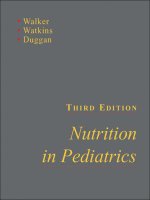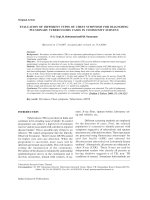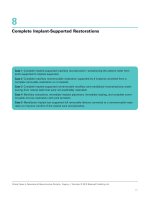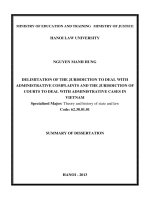100 cases in pediatrics
Bạn đang xem bản rút gọn của tài liệu. Xem và tải ngay bản đầy đủ của tài liệu tại đây (3.15 MB, 320 trang )
100 CASES
in Paediatrics
This page intentionally left blank
100 CASES
in Paediatrics
J. E. Raine MD FRCPCH DCH
Consultant Paediatrician, Whittington Hospital, London;
Honorary Senior Lecturer, University College, London, UK
A. J. Cunnington BMBCh MA MRCPCH DTM&H
Specialist Registrar in Paediatrics, London Deanery;
Clinical Research Fellow, Immunology Unit,
London School of Hygiene and Tropical Medicine, London, UK
J. M. Walker BA FRCP FRCPCH
Consultant Paediatrician, Portsmouth Hospitals NHS Trust,
Portsmouth, UK
Volume Editor:
J. E. Raine
100 Cases Series Editor:
P. John Rees M FRCP
Dean of Medical Undergraduate Education, King’s College London
School of Medicine at Guy’s, King’s and St Thomas’ Hospitals, London, UK
First published in Great Britain in 2009 by
Hodder Arnold, an imprint of Hodder Education, an Hachette UK Company,
338 Euston Road, London NW1 3BH
© 2009 Hodder Arnold
All rights reserved. Apart from any use permitted under UK copyright law, this publication may only be
reproduced, stored or transmitted, in any form, or by any means with prior permission in writing of the
publishers or in the case of reprographic production in accordance with the terms of licences issued by the
Copyright Licensing Agency. In the United Kingdom such licences are issued by the Copyright Licensing
Agency: Saffron House, 6-10 Kirby Street, London EC1N 8TS.
Whilst the advice and information in this book are believed to be true and accurate at the date of going to
press, neither the authors nor the publisher can accept any legal responsibility or liability for any errors or
omissions that may be made. In particular (but without limiting the generality of the preceding disclaimer)
every effort has been made to check drug dosages; however it is still possible that errors have been missed.
Furthermore, dosage schedules are constantly being revised and new side-effects recognized. For these reasons the reader is strongly urged to consult the drug companies' printed instructions before administering
any of the drugs recommended in this book.
British Library Cataloguing in Publication Data
A catalogue record for this book is available from the British Library
Library of Congress Cataloging-in-Publication Data
A catalog record for this book is available from the Library of Congress
ISBN 978 0 340 96875 8
1 2 3 4 5 6 7 8 9 10
Commissioning Editor:
Project Editor:
Production Controller:
Cover Designer:
Indexer:
Joanna Koster
Francesca Naish
Karen Tate
Amina Dudhia
Laurence Errington
Typeset in 10/12 Optima by Macmillan Publishing Solutions
(www.macmillansolutions.com)
Printed & bound in India
What do you think about this book? Or any other Hodder Arnold title?
Please visit our website: www.hoddereducation.com
To Laine, Kooks and Benjo
v
This page intentionally left blank
CONTENTS
Preface
Acknowledgements
List of abbreviations
Normal values
xi
xiii
xv
xvii
Respiratory
Case 1: An infant with noisy breathing
Case 2: A child with noisy breathing
Case 3: A chesty infant
Case 4: A chronic cough
Case 5: Recurrent chest infections
Case 6: A wheezy teenager
Case 7: Fever and breathlessness
Case 8: A teenager with chest pain
1
3
7
11
14
19
22
27
Cardiology
Case 9: A cyanosed newborn
Case 10: A shocked neonate
Case 11: A pale, breathless baby
Case 12: An incidental murmur
Case 13: A funny turn
29
31
33
37
41
Endocrinology and diabetes
Case 14: A thirsty boy
Case 15: A tall boy
Case 16: A short girl
Case 17: An overweight boy
Case 18: A girl with early puberty
Case 19: A boy with delayed puberty
Case 20: Is it a boy or a girl?
Case 21: A boy with breasts
Case 22: A boy with bow legs
45
47
50
53
56
59
61
63
66
Gastroenterology
Case 23: A vomiting Infant
Case 24: A child with bloody diarrhoea
Case 25: A teenager with chronic diarrhoea
Case 26: Acute diarrhoea and vomiting
Case 27: Acute abdominal pain
Case 28: Recurrent abdominal pain
Case 29: A constipated toddler
Case 30: An infant with poor weight gain
Case 31: An infant with persistent jaundice
71
73
75
79
83
85
89
92
97
vii
Contents
Case 32: Abdominal pain and jaundice
Case 33: A lump in the groin
99
101
Nephrology
Case 34: Abdominal pain and dysuria
Case 35: Red urine
Case 36: A puffy face
Case 37: A bed wetter
Case 38: High blood pressure
105
107
111
113
115
Infections
Case 39:
Case 40:
Case 41:
Case 42:
Case 43:
Case 44:
117
119
121
123
125
128
Fever and a rash
Fever in a returning traveller
Sticky eyes
A persistent fever
Recurrent infections
Unexplained weight loss
Dermatology
Case 45: An itchy rash
Case 46: Deteriorating eczema
Case 47: An infant with blisters
133
136
140
Haematology
Case 48: A pale child
Case 49: Easy bruising
Case 50: A child with chest pain
143
147
150
Oncology
Case 51:
Case 52:
Case 53:
Case 54:
Case 55:
Case 56:
155
157
161
163
165
169
An abdominal mass
An unsteady child
Lymphadenopathy
A swollen shoulder
Fever in a patient on chemotherapy
Aches and pains
Bones and joints
Case 57: A girl with a limp
Case 58: Pain and fever
Case 59: Swollen joints
Case 60: A spinal deformity
172
177
179
183
Neurology
Case 61: A fitting child
Case 62: A febrile, drowsy child
Case 63: A big head
Case 64: A child in a coma
Case 65: A late walker
Case 66: A child with learning difficulties
Case 67: Sudden weakness
Case 68: Chronic headaches
Case 69: A funny smile
185
187
190
194
197
199
201
205
207
viii
Contents
Case 70:
Case 71:
Case 72:
Case 73:
Weak legs
Developmental regression
A deaf boy
A child with a squint
209
213
217
219
Child and adolescent psychiatry
Case 74:
A boy with no friends
Case 75:
A hyperactive child
Case 76:
A teenager who won’t eat
222
225
227
Neonatology
Case 77:
Born too early
Case 78:
A breathless newborn
Case 79:
Recurrent apnoeas
Case 80:
A sudden collapse in a ventilated preterm neonate
Case 81:
Bilious vomiting in a neonate
Case 82:
A jaundiced neonate
Case 83:
A floppy infant
Case 84:
A difficult delivery
Case 85:
A newborn with congenital abnormalities
Case 86:
Sudden deterioration in a term baby
Case 87:
A case of possible trisomy 21
Case 88:
Abnormal movements in an 8-day-old baby
229
231
233
236
240
243
247
249
251
253
255
259
Miscellaneous
Case 89:
A fracture in an infant
Case 90:
A vaginal discharge
Case 91:
An odd shaped head
Case 92:
A drowsy toddler
Case 93:
A confused teenager
Case 94:
A drunken adolescent
Case 95:
An unusual appetite
Case 96:
A sudden collapse
Case 97:
A pregnant 14-year-old
Case 98:
A sudden, unexpected death
Case 99:
A tired teenager
Case 100: Poor weight gain
262
265
267
269
273
275
277
279
281
285
289
293
Index
295
ix
This page intentionally left blank
PREFACE
Paediatrics is a fascinating and multifaceted speciality. As well as dealing with the
standard medical conditions that arise in children, it covers neonatology and the preterm infant (often newcomers to a neonatal intensive care unit see it as ‘another world’),
genetics, ethics, child development, child protection, and child and adolescent psychiatry. During the short medical student paediatric attachments, and in the era of decreasing hours of work for junior doctors, the exposure to the diverse range of paediatric
conditions is limited.
In the 100 cases that follow, we have tried to cover the majority of the key areas in paediatrics. We have tackled problems that arise in different settings, such as primary care, and
emergency departments, paediatric outpatients, the paediatric ward and the maternity and
neonatal intensive care units. We hope to have done so in a way that is interesting and
that brings the cases alive. After reading through the case and questions, the reader should
carefully consider their answer and ideally commit their thoughts to paper, prior to looking at the answers over the page. We have also tried to demonstrate how a senior paediatrician would approach and work their way through the clinical problem and to explain
some underlying principles in a way that will help cement understanding and knowledge.
The book is aimed at medical students, foundation year doctors doing paediatrics and
junior doctors studying for their MRCPCH. We hope that these cases will be enjoyable
and that they will keep the ‘grey cells’ stimulated!
J E Raine
A J Cunnington
J M Walker
October 2008
xi
This page intentionally left blank
ACKNOWLEDGEMENTS
The authors would like to thank Drs Ed Broadhurst and Natasha Kapur from the
Whittington Hospital, Drs Rachael Harrison and Roy Sievers from Portsmouth
Hospitals NHS Trust, Mr Pat Malone from Southampton University NHS Trust and Dr
Joanna Danin from Imperial College Healthcare NHS Trust.
xiii
This page intentionally left blank
ABBREVIATIONS
ABC
A and E
ALSG
ALT
ALP
ANA
APLS
ASOT
AXR
BCG
BMI
BP
CNS
CPAP
CPR
CRP
CSF
CT
CXR
ECG
ED
EEG
ESR
FBC
FSH
fT4
GCS
GP
HCG
HIV
IO
LFT
LH
LHRH
LP
M,CϩS
MCV
MDI
MCH
MRI
MSU
NAI
airway, breathing, circulation
accident and emergency
Advanced Life Support Group
alanine aminotransferase
alkaline phosphatase
anti-nuclear antibody
Advanced Paediatric Life Support
anti-streptolysin O titre
abdominal X-ray
Bacillus Calmette–Gue´ rin
body mass index
blood pressure
central nervous system
continuous positive airways pressure
cardiopulmonary resuscitation
C-reactive protein
cerebrospinal fluid
computed tomography
chest X-ray
electrocardiogram
emergency department
electroencephalogram
erythrocyte sedimentation rate
full blood count
follicle-stimulating hormone
free thyroxine
Glasgow Coma Score
general practitioner
human chorionic gonadotrophin
human immunodeficiency virus
intraosseous
liver function test
luteinizing hormone
luteinizing hormone-releasing hormone
lumbar puncture
microscopy, culture and sensitivity
mean cell volume
metered dose inhaler
mean corpuscular haemoglobin
magnetic resonance imaging
midstream urine
non-accidental injury
xv
Abbreviations
NG
NAD
PCR
PEFR
PICU
p.r.n.
RAST
SLE
TB
TFT
TSH
UϩEs
URTI
US
UTI
WBC
xvi
nasogastric
no abnormality detected
polymerase chain reaction
peak expiratory flow rate
paediatric intensive care unit
as required
radioallergosorbent test
systemic lupus erythematosus
tuberculosis
thyroid function test
thyroid-stimulating hormone
urea and electrolytes
upper respiratory tract infection
ultrasound
urinary tract infection
white blood cells
NORMAL VALUES
NORMAL VALUES
Respiratory rate at rest
Age (years)
Ͻ1
1–2
2–5
5–12
Ͼ12
Respiratory rate (breaths/min)
30–40
25–35
25–30
20–25
15–20
Heart rate
Age (years)
Ͻ1
1–2
2–5
5–12
Ͼ12
Heart rate (beats/min)
110–160
100–150
95–140
80–120
60–100
Systolic blood pressure
Age (years)
Ͻ1
1–2
2–5
5–12
Ͼ12
Systolic blood pressure (mmHg)
70–90
80–95
80–100
90–110
100–120
(Reproduced with kind permission of the Advanced Life Support Group from
Advanced Paediatric Life Support, Blackwell Publishing, 2005.)
xvii
This page intentionally left blank
RESPIRATORY
CASE 1: AN INFANT WITH NOISY BREATHING
History
Mohammed is a 3-month-old boy, brought to a paediatric rapid referral clinic because of
persistent noisy breathing. He was born in the UK at term after an uneventful pregnancy and
is the fifth child of non-consanguineous Somalian parents. His birth weight was 3.7 kg (75th
centile). Since he was a few weeks old, he has had noisy breathing, which hasn’t affected his
feeding, and his parents were repeatedly reassured that it would get better. He has continued
to have intermittent noisy breathing, especially when agitated, and sometimes during sleep.
Over the last few days, his breathing has been noisier than usual. Otherwise he has been well
without any fevers. All of his siblings have recently had coughs and colds.
Examination
He is active and smiles responsively. Oxygen saturations are 95 per cent in air and his
temperature is 36.9ºC. He is coryzal and has intermittent stridor. There is a small ‘strawberry’ haemangioma on his forehead. Respiratory rate is 45/min, there is subcostal recession and mild tracheal tug. Air entry is symmetrical in the chest, with no crackles or
wheeze. Cardiovascular examination is unremarkable. His weight is 6.7 kg (75th centile).
Questions
• What is the most likely cause of his stridor?
• What other important diagnoses need to be considered?
• How can the diagnosis be confirmed?
1
100 Cases in Paediatrics
ANSWER 1
Stridor is an inspiratory sound due to narrowing of the upper airway. Mohammed is most
likely to have stridor due to laryngomalacia. This means that the laryngeal cartilage is soft
and floppy, with an abnormal epiglottis and/or arytenoid cartilages. The larynx collapses
and narrows during inspiration (when there is a negative intrathoracic pressure), resulting in
inspiratory stridor. It is usually a benign condition with noisy breathing but no major problems with feeding or significant respiratory distress. Most cases resolve spontaneously within
a year as the larynx grows and the cartilaginous rings stiffen. The reason Mohammed now
has respiratory distress is that he has an intercurrent viral upper respiratory tract infection.
A very important diagnosis to consider in this boy is a haemangioma in the upper airway.
The majority of haemangiomas are single cutaneous lesions, but they can also occur at
other sites and the upper airway is one position where they can enlarge with potentially
life-threatening consequences. The presence of one haemangioma increases the likelihood
of a second one. This boy should be referred for assessment by an ENT surgeon.
There are many other possible congenital causes of stridor which affect the structure or
function of the upper airway. Infectious causes of stridor, such as croup and epiglottitis,
are very rare in this age group.
!
Differential diagnosis of stridor in an infant
Laryngomalacia
Laryngeal cyst, haemangioma or web
Laryngeal stenosis
Vocal cord paralysis
Vascular ring
Gastro-oesophageal reflux
Hypocalcaemia (laryngeal tetany)
Respiratory papillomatosis
Subglottic stenosis
•
•
•
•
•
•
•
•
•
The diagnosis of laryngomalacia can be confirmed by visualization of the larynx using
flexible laryngoscopy. This can be done by an ENT surgeon as an outpatient procedure.
This demonstrates prolapse over the airway of an omega-shaped epiglottis or arytenoid
cartilages. Congenital structural abnormalities may also be seen. Lesions below the vocal
cords may require bronchoscopy, CT or an MRI scan for diagnosis.
KEY POINTS
• The commonest cause of congenital stridor is laryngomalacia.
• Laryngomalacia can be exacerbated by intercurrent respiratory infections.
2
CASE 2:
A CHILD WITH NOISY BREATHING
History
Ewa is a 4-year-old child who presents to the ED with a sudden onset of noisy breathing.
She has had a runny nose for 2 days, a cough for 1 day and developed noisy breathing
3 hours earlier. Her mother feels that she is getting progressively more breathless. Her father
had a cold the previous week. She is otherwise well but has troublesome eczema which is
treated with emulsifiers and steroid creams. Her mother states that she is allergic to peanuts,
as they lead to a deterioration of the eczema within 1–2 hours. She avoids peanuts and all
types of nuts. She is fully immunized. Her 8-year-old sister has asthma.
Examination
Oxygen saturation is 89 per cent in air. Her temperature is 38.0ЊC. There is loud noisy breathing, mainly on inspiration. Her respiratory rate is 52/min with supracostal and intercostal
recession. On auscultation, there are no crackles or wheezes. There are no other signs.
Questions
• What is the most likely diagnosis?
• What is the differential diagnosis?
• What is the treatment?
3
100 Cases in Paediatrics
ANSWER 2
The most likely diagnosis is laryngotracheobronchitis (croup). This child has stridor, which
is an inspiratory sound secondary to narrowing of the upper airway. In contrast, wheeze
is an expiratory sound caused by narrowing of the lower airways. The effort required to
shift air through the narrowed airway has resulted in tachypnoea and recession.
The upper airway of a child with stridor should not be examined and the child should
not be upset by performing painful procedures such as blood tests. This is because
there is a small risk that this may lead to a deterioration, causing partial obstruction to
progress to complete obstruction and a respiratory arrest.
!
Differential diagnosis of acute stridor
•
•
•
•
•
Laryngotracheobronchitis
Inhaled foreign body
Anaphylaxis
Epiglottitis
Rare causes include:
– Bacterial tracheitis
– Severe tonsillitis with very large tonsils
– Inhalation of hot gases (e.g. house fire)
– Retropharyngeal abscess
Croup typically occurs in children aged 6 months to 5 years. It is characterized by an
upper respiratory tract infection that is followed by a barking-type cough, a hoarse
voice, stridor and a low-grade fever. Croup is most commonly caused by the parainfluenza virus.
When a foreign body is inhaled, there is usually a history of sudden coughing and/or choking in a child that was previously well. There may be accompanying cyanosis. The foreign
body is usually a food (e.g. peanut) but may be a small toy. On examination there may be a
unilateral wheeze with decreased air entry on one side.
This case is not typical of anaphylaxis, in that there is no history of the child having
had peanuts. Nor are there features that often accompany anaphylaxis, such as an itchy
urticarial rash, facial swelling, vomiting, wheeze or hypotension.
Epiglottitis would be very unlikely in a fully immunized child who would have received
the Haemophilus influenzae vaccine.
Initial management deals with the ABC. As the oxygen saturation is low, high-flow 100
per cent oxygen will be needed to elevate the saturation to у95 per cent.
The first step in the treatment of croup is oral dexamethasone. A less frequently used
alternative is nebulized budesonide. If 2–3 hours later the child has improved and the
oxygen saturation is у95 per cent in air, the child can be discharged. In some cases
a further dose of steroids can be administered 12–24 hours later. If the child deteriorates then nebulized adrenaline can be administered. If adrenaline is required then senior
help and an anaesthetist should be summoned urgently. If the child deteriorates further
(increasing tachypnoea, recession and exhaustion) then intubation and ventilation are
4
Respiratory
required to secure the airway and to prevent hypoxia and its sequelae. If intubation is
unsuccessful, an ENT surgeon will be required to perform an emergency tracheostomy.
KEY POINTS
• Stridor is due to upper airway obstruction.
• The upper airway of a child with stridor should not be examined as this may
precipitate total obstruction.
• Laryngotracheobronchitis is the commonest cause of acute stridor.
5
This page intentionally left blank









